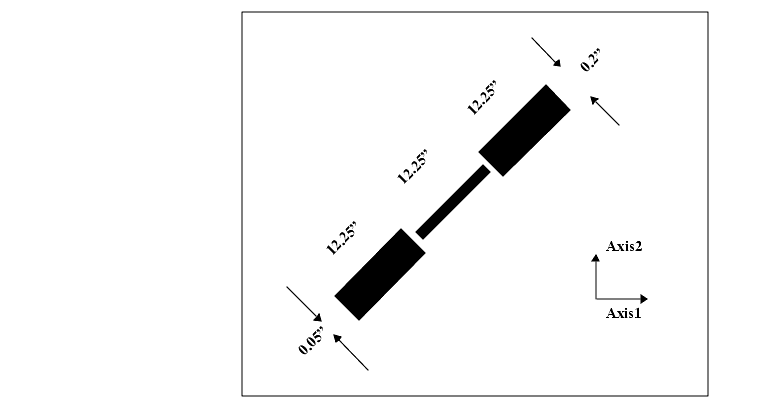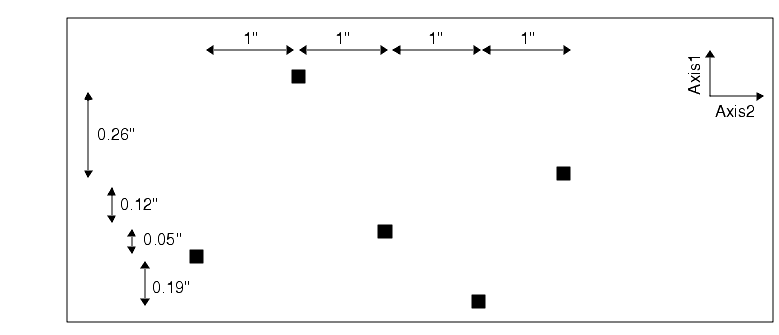



The STIS aperture wheel has 65 positions, several of which correspond to multiple slits or masks. Only a small fraction of the full complement of spectroscopic apertures are currently supported. Table A.1 provides a complete list of STIS apertures for spectroscopy, together with comments regarding their characteristics or purposes. Schematics of three complex apertures are given in Figure A.1, Figure A.2 and Figure A.3.
| Apertures |
Comments |
|---|---|
| Apertures that can be used with the First-Order Gratings and the NUV-PRISM |
|
| 52X0.05 52X0.1 52X0.2 52X0.5 52X2 |
Long slits; the names give the length in the spatial direction by the width in the dispersion direction in arcseconds. |
| 52X0.05E1 52X0.1E1 52X0.2E1 52X0.5E1 52X2E1 |
Long slits centered at 19.7 arcsec in +Y position. (Places compact target at row ~900 on the CCD to reduce CTE losses.). Supported with all CCD gratings. Use with the MAMAs is not allowed. |
| 52X0.2E2 52X0.5E2 52X2E2 |
These CTE aperture positions are also centered near row 900 on the STIS CCD detector. However, the positions are offset from the physical aperture centers to give better alignment with fringe flats done using the 52X0.1 aperture. The E2 positions are supported for the G750L and G750M gratings only. |
| 52X0.05D1 52X0.1D1 52X0.2D1 52X0.5D1 52X2D1 |
These aperture positions put a target 2" above the bottom edge of the FUV-MAMA, and are intended for observation of very faint targets where it is necessary to minimize the contribution of the FUV-MAMA dark current. They are all supported with the G140L and G140M gratings. 52X0.05D1 and 52X0.1D1 are also supported for CCD peakups. |
52X0.05F1 52X0.05F2 52X0.1F1 52X0.1F2 52X0.2F1 52X0.2F2 52X0.5F1 52X0.5F2 52X2F1 52X2F2 |
Fiducial bars on the long slits which can be used for coronagraphic spectroscopy. The 52X0.2F1 is supported for all first order gratings, and is available-but-unsupported for the PRISM. The other fiducial bars are available-but-unsupported with all gratings and the PRISM. |
52X0.1B0.5 52X0.1B1.0 52X0.1B3.0 |
A long slit with 3 fiducial bars where the bar length in arcseconds is given by the third dimension. See Figure A.1. |
31X0.05NDA 31X0.05NDB 31X0.05NDC |
Neutral-density-filtered long slits of the given dimensions in arcsec, which may be used for bright objects or flat-field calibration. The dex ND factors are 0.4, 0.8 and 1.2, respectively. |
0.5x0.5 2X2 6X6 |
Square apertures of the given dimensions in arcsec. |
| 0.1X0.03 0.1X0.06 0.1X0.09 0.1X0.2 0.2X0.06 0.2X0.09 0.2X0.2 0.2X0.5 0.3X0.06 0.3X0.09 0.3X0.2 1X0.06 1X0.2 6X0.06 6X0.2 6X0.5 0.2X0.05ND 0.3X0.05ND 0.2X0.06FP 0.2X0.2FP |
As of Cycle 12, the 0.2X0.2 aperture is supported for use with all 1st order gratings; it is available-but-unsupported with the PRISM. While not supported for first order observations, the other echelle apertures can be used in first order as available-but-unsupported apertures. This includes the echelle neutral density slits 0.2X0.05ND and 0.3X0.05ND with dex ND factors of 2.0 and 3.0 respectively. |
| 25MAMA 50CCD |
Supported full-field clear apertures. |
| F25QTZ F25SRF2 |
F25QTZ and F25SRF2 are supported for all MAMA gratings and PRISM, but are unavailable with the CCD. |
| 25MAMAD1 F25SRF2D1 F25QTZD1 |
These aperture positions put a target 2" above the bottom edge of the FUV-MAMA, and are intended for observation of very faint targets where it is necessary to minimize the contribution of the FUV-MAMA dark current. They are all supported with the G140L and G140M gratings. |
| F25ND3 F25ND5 F25NDQ1 F25NDQ2 F25NDQ3 F25NDQ4 |
Supported neutral-density filters for MAMA detectors. Can be used as available-but-unsupported apertures with the CCD gratings. |
| F25MGII F25CN270 F25CIII F25CN182 |
F25MGII is supported and these other filters are available -but-unsupported with the NUV-MAMA gratings and PRISM only. |
F25LYA |
The F25LYA filter is available-but-unsupported with the G140L, G140M, E140H, and E140M gratings only. |
F28X50LP F28X50OII F28X50OIII |
These CCD imaging filters are available-but-unsupported with the CCD gratings, but are unavailable with the MAMA detectors. |
36X0.05P45 36X0.05N45 36X0.6P45 36X0.6N45 |
Long slits of the given dimensions in arcsec which are inclined at ±45° to facilitate observations of moving targets at off-nominal rolls. See Figure A.1. |
| Apertures that can be used with the Echelle Gratings |
|
| 0.1X0.03 0.1X0.06 0.1X0.09 0.1X0.2 |
The latter two are supported with E230H only The 0.1x0.03 is supported with all echelle gratings. |
| 0.2X0.06 0.2X0.09 0.2X0.2 0.2X0.5 |
0.2X0.06 and 0.2X0.2 are supported with E230M and E140M, while 0.2X0.09 and 0.2X0.2 are supported with E230H and E140H. |
| 0.2X0.06FP 0.2X0.2FP |
Masks with five apertures, suffixed A through E, for reduction of fixed-pattern noise; see Figure A.3. |
| 0.2X0.05ND 0.3X0.05ND |
Neutral-density slits. Dex ND factors are 2.0 and 3.0, respectively. |
0.3X0.06 0.3X0.09 0.3X0.2 0.5X0.5 1X0.06 1X0.2 |
Miscellaneous available-but-unsupported echelle apertures. |
| 2X2 6X0.06 6X0.2 6X0.5 6X6 |
The 6X0.2 long slit is supported with the echelles. |
| 52X0.05 52X0.1 52X0.2 52x0.5 52X2 |
Long slits for use with the echelles. 52X0.05 is supported, and the others are available-but-unsupported with the echelle gratings. |
| 52X0.05F1 52X0.05F2 52X0.1F1 52X0.1F2 52X0.2F1 52X0.2F2 52X0.5F1 52X0.5F2 52X2F1 52X2F2 |
The fiducial bar slits are available-but-unsupported with the echelle gratings. |
| 52X0.1B0.5 52x0.1B1.0 52x0.1B3.0 |
A long slit with 3 fiducial bars. The bar length in arcseconds is given by the third dimension. See Figure A.1. |
31X0.05NDA 31X0.05NDB 31X0.05NDC |
Neutral-density-filtered long slits, which may be used for bright objects. The dex ND factors are 0.4, 0.8 and 1.2, respectively. |
| 25MAMA |
Full-field clear aperture. |
| F25QTZ F25SRF2 |
Supported long-pass filters. Both are supported for E140H and E140M, but are unavailable with the NUV-MAMA. |
| F25ND3 F25ND5 F25NDQ1 F25NDQ2 F25NDQ F25NDQ4 |
Supported neutral-density filters for MAMA detectors. |
| F25MGII F25CN270 F25CIII F25CN182 |
Narrow-band filters. F25MGII is supported for E230H and E230M. Others are available with the NUV-MAMA only. |
| F25LYA |
Available-but-unsupported with the FUV-MAMA only. |
36X0.05P45 36X0.05N45 36X0.6P45 36X0.6N45 |
Long slits which are inclined at ±45° to facilitate observations of moving targets at off-nominal rolls. See Figure A.2. |



The 45° slits ( Figure A.2) are nominally inclined at plus or minus that angle with respect to the dispersion and normal long slit, in order to increase the scheduling flexibility for moving target observations with specified position angles. Otherwise, the HST roll angle constraints severely limit the windows for such observations. These slits have different widths in their central and outer segments, and there are two pairs with different dimensions.
The fixed-pattern slits ( Figure A.3) comprise two masks with five apertures each, which are spaced to place the spectrum at different detector locations designed to optimize the reduction of fixed-pattern noise. The target is moved from one aperture to another, and the slit wheel is repositioned, with the intention that the spectrum shifts along the dispersion direction only. See Section 12.5.2 for further details.
It is not feasible to provide detailed transmission properties of all of the unsupported apertures at this time. They can in many cases be estimated from the data provided for similar supported apertures in Chapter 13, and from the imaging data in Table 14.38.


|
Space Telescope Science Institute http://www.stsci.edu Voice: (410) 338-1082 help@stsci.edu |